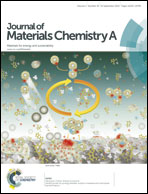Glucosamine-derived encapsulation of silicon nanoparticles for high-performance lithium ion batteries†
Abstract
The use of nitrogen-doped carbon (NC) layers has proved effective for enhancing the cycling stability of nanostructured silicon (Si) anodes of lithium ion batteries. It has also motivated further exploration of cost- and performance-effective synthetic routes. In this regard, we propose glucosamine-derived encapsulation of Si nanoparticles (NPs), which features the use of inexpensive glucosamine as a N-containing carbon source, and conventional solution-coating and carbonization processes. With this method, a 5 nm-thick, uniform and defect-free NC layer, with pyridinic and pyrrolic nitrogen, was successfully created on Si NPs. The NC–Si anode derived from glucosamine exhibited a reversible capacity of 1775 mA h g−1 at a current density of 2000 mA g−1 after 100 cycles, and 69% capacity retention with a 20-fold increase in the current rate (from 200 mA g−1 to 4000 mA g−1). Electrochemical and spectroscopic analyses suggest the formation of a more stable solid electrolyte interface (SEI) layer of lower resistance, higher homogeneity, and higher LiF content after N-doping. Therefore, this is a cost-effective approach for enhancing the performance of Si anodes.


 Please wait while we load your content...
Please wait while we load your content...